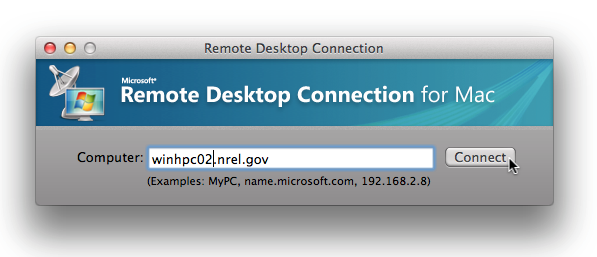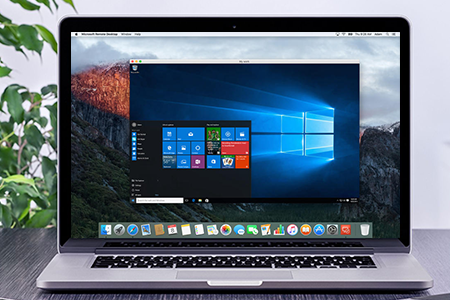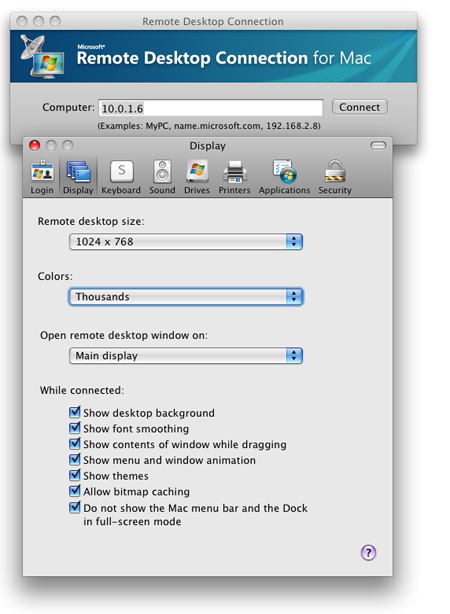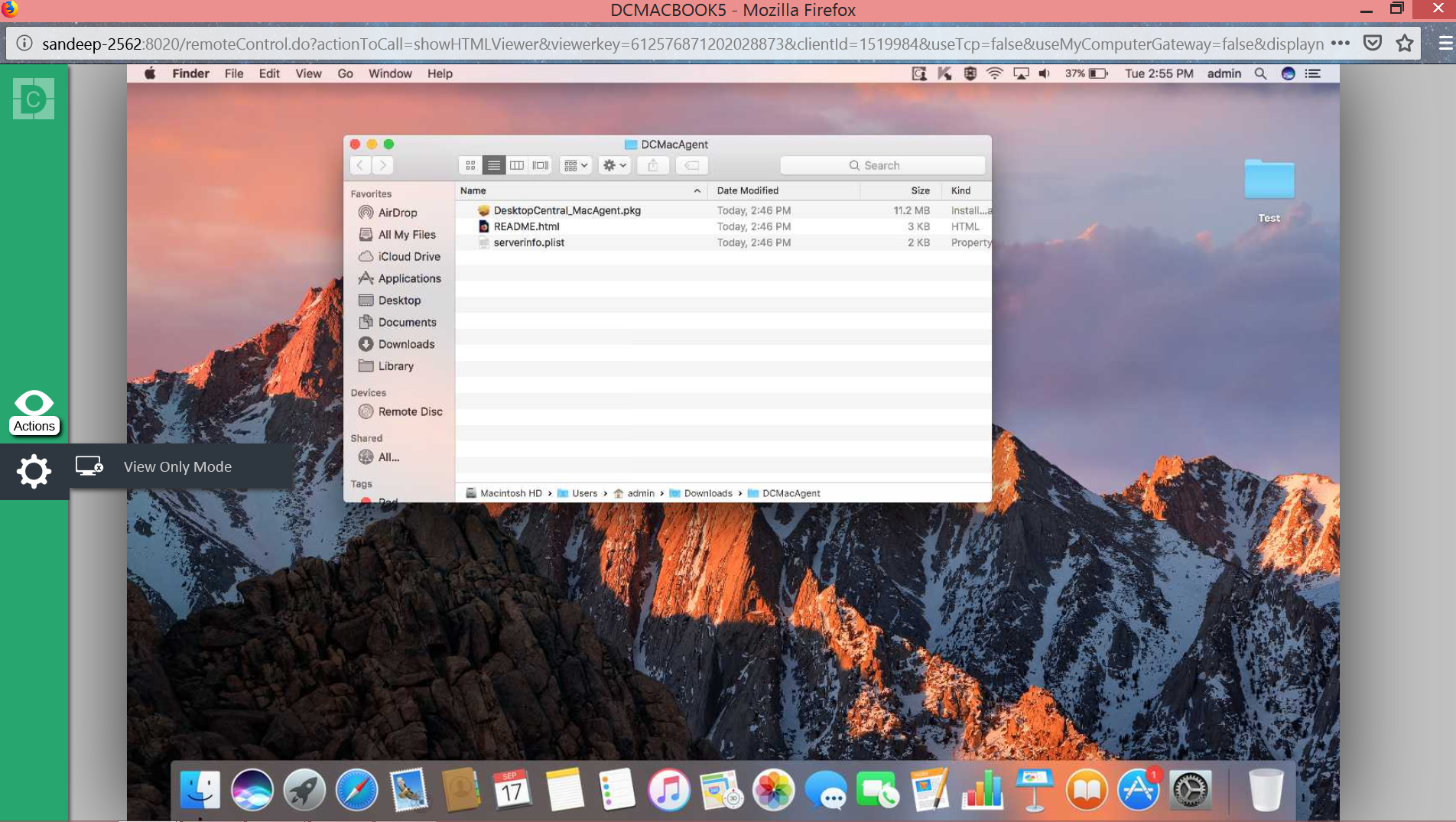Mac High Sierra 10.13.6 - I have been using Microsoft Remote Desktop to connect to a Windows 10 Pro computer through a VPN without issue until Friday August 7th, suddenly it refused to connect. Please help - I use this for work. Remote Desktop Connection Manager 2.7. RDCMan manages multiple remote desktop connections. Tool Remote Server Administration Tools for Windows 7 with Service Pack 1 (SP1). In this video, I'll show you how to use Microsoft Remote Desktop on a Mac. Simply download the application from Apple's App store, install, and configure a c. Mac to Mac Remote Desktop Connection. Remote Desktop Connection for Macintosh. Here’s how you can remotely connect and control one Macintosh computer from another. Due to changes in our firewall, a VPN is now required when doing this from off-campus. The on-campus computer must be left on and not in hibernation. Connect your Mac to the Windows computer using a standard Ethernet cable. If your Mac doesn’t have an Ethernet port, try using a USB-to-Ethernet adapter. Connecting the two computers creates a small local network that consists of just the two computers. On the Windows computer, turn on file sharing.
Applies To: Windows 10, Windows 8.1, Windows Server 2012 R2, Windows Server 2016
You can use the Remote Desktop client for Mac to work with Windows apps, resources, and desktops from your Mac computer. Use the following information to get started - and check out the FAQ if you have questions.
Note
- Curious about the new releases for the macOS client? Check out What's new for Remote Desktop on Mac?
- The Mac client runs on computers running macOS 10.10 and newer.
- The information in this article applies primarily to the full version of the Mac client - the version available in the Mac AppStore. Test-drive new features by downloading our preview app here: beta client release notes.
Get the Remote Desktop client
Follow these steps to get started with Remote Desktop on your Mac:
- Download the Microsoft Remote Desktop client from the Mac App Store.
- Set up your PC to accept remote connections. (If you skip this step, you can't connect to your PC.)
- Add a Remote Desktop connection or a remote resource. You use a connection to connect directly to a Windows PC and a remote resource to use a RemoteApp program, session-based desktop, or a virtual desktop published on-premises using RemoteApp and Desktop Connections. This feature is typically available in corporate environments.
What about the Mac beta client?
We're testing new features on our preview channel on AppCenter. Want to check it out? Go to Microsoft Remote Desktop for Mac and select Download. You don't need to create an account or sign into AppCenter to download the beta client.
If you already have the client, you can check for updates to ensure you have the latest version. In the beta client, select Microsoft Remote Desktop Beta at the top, and then select Check for updates.
Add a workspace
Subscribe to the feed your admin gave you to get the list of managed resources available to you on your macOS device.
To subscribe to a feed:
- Select Add feed on the main page to connect to the service and retrieve your resources.
- Enter the feed URL. This can be a URL or email address:
- This URL is usually a Windows Virtual Desktop URL. Which one you use depends on which version of Windows Virtual Desktop you're using.
- For Windows Virtual Desktop (classic), use
https://rdweb.wvd.microsoft.com/api/feeddiscovery/webfeeddiscovery.aspx. - For Windows Virtual Desktop, use
https://rdweb.wvd.microsoft.com/api/arm/feeddiscovery.
- For Windows Virtual Desktop (classic), use
- To use email, enter your email address. This tells the client to search for a URL associated with your email address if your admin configured the server that way.
- This URL is usually a Windows Virtual Desktop URL. Which one you use depends on which version of Windows Virtual Desktop you're using.
- Select Subscribe.
- Sign in with your user account when prompted.
After you've signed in, you should see a list of available resources.
Once you've subscribed to a feed, the feed's content will update automatically on a regular basis. Resources may be added, changed, or removed based on changes made by your administrator.
Export and import connections
You can export a remote desktop connection definition and use it on a different device. Remote desktops are saved in separate RDP files.
To export an RDP file:
- In the Connection Center, right-click the remote desktop.
- Select Export.
- Browse to the location where you want to save the remote desktop RDP file.
- Select OK.
To import an RDP file:
- In the menu bar, select File > Import.
- Browse to the RDP file.
- Select Open.
Add a remote resource
Remote resources are RemoteApp programs, session-based desktops, and virtual desktops published using RemoteApp and Desktop Connections.
- The URL displays the link to the RD Web Access server that gives you access to RemoteApp and Desktop Connections.
- The configured RemoteApp and Desktop Connections are listed.
To add a remote resource:
- In the Connection Center select +, and then select Add Remote Resources.
- Enter information for the remote resource:
- Feed URL - The URL of the RD Web Access server. You can also enter your corporate email account in this field – this tells the client to search for the RD Web Access Server associated with your email address.
- User name - The user name to use for the RD Web Access server you are connecting to.
- Password - The password to use for the RD Web Access server you are connecting to.
- Select Save.
The remote resources will be displayed in the Connection Center.
Connect to an RD Gateway to access internal assets
A Remote Desktop Gateway (RD Gateway) lets you connect to a remote computer on a corporate network from anywhere on the Internet. You can create and manage your gateways in the preferences of the app or while setting up a new desktop connection.
To set up a new gateway in preferences:
- In the Connection Center, select Preferences > Gateways.
- Select the + button at the bottom of the table Enter the following information:
- Server name – The name of the computer you want to use as a gateway. This can be a Windows computer name, an Internet domain name, or an IP address. You can also add port information to the server name (for example: RDGateway:443 or 10.0.0.1:443).
- User name - The user name and password to be used for the Remote Desktop gateway you are connecting to. You can also select Use connection credentials to use the same user name and password as those used for the remote desktop connection.
Manage your user accounts

When you connect to a desktop or remote resources, you can save the user accounts to select from again. You can manage your user accounts by using the Remote Desktop client.
To create a new user account:
- In the Connection Center, select Settings > Accounts.
- Select Add User Account.
- Enter the following information:
- User Name - The name of the user to save for use with a remote connection. You can enter the user name in any of the following formats: user_name, domainuser_name, or user_name@domain.com.
- Password - The password for the user you specified. Every user account that you want to save to use for remote connections needs to have a password associated with it.
- Friendly Name - If you are using the same user account with different passwords, set a friendly name to distinguish those user accounts.
- Select Save, then select Settings.
Customize your display resolution
You can specify the display resolution for the remote desktop session.
- In the Connection Center, select Preferences.
- Select Resolution.
- Select +.
- Enter a resolution height and width, and then select OK.
To delete the resolution, select it, and then select -.
Displays have separate spaces
If you're running Mac OS X 10.9 and have disabled Displays have separate spaces in Mavericks (System Preferences > Mission Control), you need to configure this setting in the Remote Desktop client using the same option.
Drive redirection for remote resources
Drive redirection is supported for remote resources, so that you can save files created with a remote application locally to your Mac. The redirected folder is always your home directory displayed as a network drive in the remote session.
Note
In order to use this feature, the administrator needs to set the appropriate settings on the server.
Remote Desktop For Mac Download
Use a keyboard in a remote session
Mac keyboard layouts differ from the Windows keyboard layouts.
- The Command key on the Mac keyboard equals the Windows key.
- To perform actions that use the Command button on the Mac, you will need to use the control button in Windows (for example Copy = Ctrl+C).
- The function keys can be activated in the session by pressing additionally the FN key (for example, FN+F1).
- The Alt key to the right of the space bar on the Mac keyboard equals the Alt Gr/right Alt key in Windows.
Mac Desktop Pc
By default, the remote session will use the same keyboard locale as the OS you're running the client on. (If your Mac is running an en-us OS, that will be used for the remote sessions as well.) If the OS keyboard locale is not used, check the keyboard setting on the remote PC and change it manually. See the Remote Desktop Client FAQ for more information about keyboards and locales.
Support for Remote Desktop gateway pluggable authentication and authorization
Windows Server 2012 R2 introduced support for a new authentication method, Remote Desktop Gateway pluggable authentication and authorization, which provides more flexibility for custom authentication routines. You can now try this authentication model with the Mac client.
Important
Custom authentication and authorization models before Windows 8.1 aren't supported, although the article above discusses them.

To learn more about this feature, check out https://aka.ms/paa-sample.
Tip
Questions and comments are always welcome. However, please do NOT post a request for troubleshooting help by using the comment feature at the end of this article. Instead, go to the Remote Desktop client forum and start a new thread. Have a feature suggestion? Tell us in the client user voice forum.
As an IT systems administrator or manager, it’s important to have the appropriate tools at your disposal to get your work done efficiently and accurately. Remote desktop connection tools are a key piece of the puzzle because they help you with troubleshooting and help you quickly resolve end-user issues.
Manually managing remote connections eats up time you could be spending on higher priority tasks. Using a remote desktop connection manager allows you to focus on more important things. My top choices are SolarWinds® Dameware® Remote Support (DRS) for on-premises use and SolarWinds Dameware Remote Everywhere (DRE) for use in the cloud. Read on to learn more about the best remote desktop connection managers or click on the links below to jump ahead to each tool review.
- Devolutions Remote Desktop Manager
What Is a Remote Desktop Connection Manager?
A remote desktop connection manager is used to manage remote desktop administration for the different connections and sessions you have. Typical enterprises have multiple Remote Desktop Protocol (RDP) sessions per day and managing these manually means having to repeatedly enter your credentials. Logging in and keeping track of these sessions can become tiresome even without having to make SSH or Telnet connections for troubleshooting.
A remote desktop connection manager or RDP client consolidates your connections in one place, so you don’t have to log in to numerous remote connection sessions per day.
Best Remote Desktop Connection Managers 2020
There are several good remote desktop connection managers available in 2020. Here are my top five.

1. SolarWinds Dameware Remote Support
One of my top choices for a remote desktop connection manager, Dameware Remote Support, is a high-quality remote administration software designed to help you provide efficient end-user support when something goes wrong.
DRS supports multiple platforms, including Windows, Mac OS X, and Linux, and it comes with several utilities to help with remote control and troubleshooting. First, it can connect either through a LAN or over the internet. This facilitates troubleshooting through distributed networks and gives you the ability to fix a problem even when the LAN is having issues. Second, you can use DRS to stop, start, or reboot processes and services. Additionally, you can use it to copy and delete files and view and clear event logs.
DRS also provides you with several direct system tools and TCP utilities, allowing you to remotely troubleshoot without having to launch a full remote session. This helps keep productivity disruptions to a minimum while the problem is resolved.
DRS provides numerous Active Directory and user account management tools to manage and set up your Active Directory users, groups, and domains. In addition, you can remotely edit policies, reset passwords, and unlock accounts.
You can also centrally manage who has access to DRS itself and set up login processes, so you don’t have to re-enter credentials every time. With multi-factor authentication, DRS is a safe way to manage remote access troubleshooting within your IT environment.
Remote Desktop Connection For Mac Setup

You can download a free trial of Dameware Remote Support for up to 14 days.

2. SolarWinds Dameware Remote Everywhere
My other top choice is Dameware Remote Everywhere, another tool offered by SolarWinds. DRE provides many of the same features as DRS but is specifically designed for a cloud environment. It also provides a few extra features, such as remote connection to mobile devices, live chat and connection for troubleshooting (including VoIP and videoconferencing), and support for Android and iOS devices.
Otherwise, it’s essentially the same tool. It’s sold as an annual license—with included product support—for use in a cloud setting. Additionally, the tool integrates with SolarWinds Service Desk to provide a complete service and troubleshooting approach.
Like Dameware Remote Support, you can access a free trial of Dameware Remote Everywhere for 14 days.
3. Microsoft Remote Desktop Connection Manager (RDCMan)
Microsoft Remote Desktop Connection Manager (RDCMan) is useful for establishing regular remote connections. Like other tools, it can save login credentials, so you don’t need to enter your credentials every time you want to create a remote connection.
RDCMan also supports connections between virtual machines and consoles, allows you to establish smart groups, and gives you the ability to import servers from a text file. This tool is useful for supporting RDP connections, but it cannot support other protocols for a broader range of remote connections. It’s essentially an RDP client, and other tools are much broader in terms of their protocol offerings.
You can download RDCMan for free through the Microsoft website.
4. Devolutions Remote Desktop Manager
With this remote desktop manager, you can automatically launch and consolidate connections in one centralized window. You can also save your login credentials with “one-click” connections, making it easier to manage multiple remote sessions.
Devolutions Remote Desktop Manager makes it possible to share your remote sessions with your team members and manage and control other users’ access to accounts. With secure password vaults and two-factor authentication, this tool takes a secure approach to remote desktop connection management.
A free trial of the Enterprise Edition is available.
5. mRemoteNG
mRemoteNG is an open-source software designed to serve as a centralized tool for managing remote connections. It allows you to see your remote connections in an interface relying on a tabbing system, and it supports several protocols for establishing remote connections, including RDP, VNC, ICA, SSH, Telnet, HTTP/HTTPS, rlogin, and raw socket connections.
This free tool is light on features. As such, it’s best suited for home users and IT staff in a small business without the budget for a professional tool.
How to Choose the Best Remote Desktop Connection Manager Tool
When considering the right remote desktop manager for your business, think about the size of the company and the kind of problems you’re trying to solve. If you’re a small or midsized business or you want to play around with remote desktop connection management, a free tool may be enough. However, large companies will need a premium tool with a broader range of features to support complex and distributed troubleshooting.
For IT professionals looking for an on-premises solution, I recommend Dameware Remote Support. For a cloud system, my pick is Dameware Remote Everywhere. These and other premium tools offer free trials, which can help you choose the right tool for your business.
